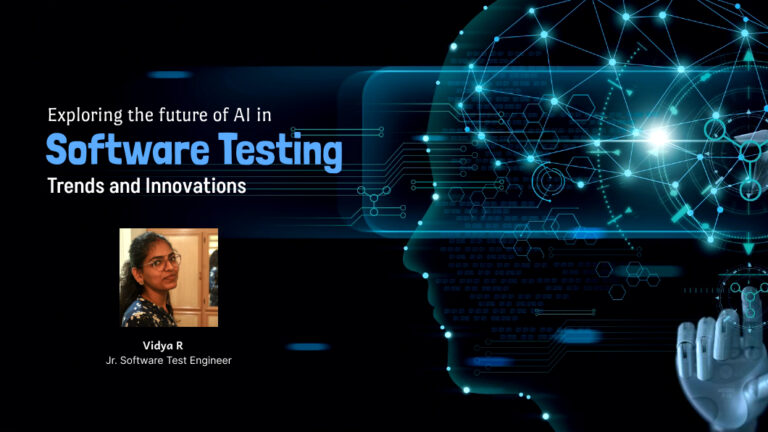
Understanding AI’s Impact on Software Testing
Software testing is an integral phase of software development, ensuring the quality and functionality of applications. As technology evolves, the integration of Artificial Intelligence (AI) has transformed the landscape of software testing methodologies.
AI-Powered Test Automation Tools
AI-driven test automation tools streamline repetitive tasks, enhancing testing efficiency and accuracy. These tools employ machine learning algorithms to analyze data, predict outcomes, and automate test cases across various scenarios.
Benefits of AI in Software Testing
AI’s incorporation brings numerous benefits, including improved test coverage, quicker test execution, and enhanced bug detection. It optimizes resource utilization, reduces costs, and ultimately results in higher software reliability.
Current Trends in AI-Enabled Software Testing
Shift-Left Testing Approach
AI facilitates the implementation of a “Shift-Left” approach, emphasizing early testing in the software development lifecycle. It ensures early bug detection, reduces fixes’ costs, and accelerates time-to-market.
AI-Driven Test Data Generation
AI algorithms generate diverse test data, enabling comprehensive test coverage. They analyze patterns, historical data, and real-time inputs to create scenarios that mimic real-world conditions, enhancing test accuracy.
Predictive Analytics for Defect Management
Utilizing predictive analytics, AI identifies potential defects based on historical data, code changes, and testing patterns. It helps prioritize testing efforts, focusing on critical areas prone to errors.
Innovations Shaping the Future of AI in Software Testing
Evolution of AI-Powered Testbots
AI-driven testbots continuously evolve by learning from each testing cycle. They adapt to changes in software features, improving their ability to detect and report defects accurately.
AI-Enabled Performance Testing
AI enhances performance testing by analyzing system behavior under various conditions. It predicts system performance, identifies bottlenecks, and recommends optimizations for better scalability and reliability.

Benefits of AI in Test Automation
Increased Test Coverage and Efficiency AI-based automation enhances test coverage by handling repetitive tasks swiftly and accurately. It allows testers to focus on more complex scenarios, ultimately improving the overall efficiency of the testing process.
Improved Accuracy and Reliability AI-driven tools exhibit high accuracy in detecting defects and vulnerabilities within the software. They reduce human error and provide reliable results, ensuring a higher-quality end product.
Faster Time-to-Market The use of AI in testing accelerates the software development life cycle. Quick identification and resolution of bugs expedite the release process, enabling faster time-to-market for products.
Challenges and Limitations
Dependency on Quality Training Data AI tools heavily rely on quality training data for accurate predictions and analysis. Insufficient or biased data can lead to misleading results, impacting the effectiveness of AI-driven testing.
Complex Implementation and Maintenance Implementing AI-based testing tools requires specialized skills and resources. Moreover, maintaining and updating these tools to adapt to evolving software can pose challenges for organizations.
The Future Outlook
Integration of AI with DevOps Practices The future of software testing lies in the integration of AI with DevOps methodologies. This convergence fosters a culture of continuous testing and delivery, ensuring high-quality software at a rapid pace.
AI-Driven Autonomous Testing Anticipate the emergence of autonomous testing, where AI systems independently design, execute, and evaluate test cases, significantly reducing human intervention in the testing process.
The Role of AI-Powered Tools in Future Software Testing
AI-Driven Automation in Testing:
Revolutionizing Test Automation AI-driven tools are revolutionizing test automation in the software development lifecycle. By harnessing machine learning algorithms, these tools enhance test coverage, reduce human intervention, and accelerate the testing process. They intelligently predict potential defects, allowing testers to focus on more critical areas while minimizing routine tasks.
Enhanced Test Coverage AI-driven automation tools excel in providing comprehensive test coverage. They simulate diverse scenarios, identify edge cases, and execute tests across multiple platforms, ensuring software quality across various environments. This approach helps in uncovering hidden bugs that traditional testing might overlook.
Reduced Time-to-Market One of the primary advantages of AI-based testing tools is their ability to expedite the software development process. By automating repetitive tasks and executing tests swiftly, these tools significantly reduce time-to-market without compromising quality, enabling faster product releases and iterations.
AI-Powered Predictive Analytics:
Predictive Defect Analysis AI’s predictive analytics capabilities empower testers to anticipate potential defects before they occur. By analyzing historical data and patterns, AI models predict where vulnerabilities might arise, enabling proactive bug resolution. This foresight allows for preemptive measures, preventing critical issues from impacting the final product.
Early Bug Detection AI algorithms can analyze code changes in real time and predict potential defects at an early stage. This proactive approach helps in addressing issues before they escalate, saving both time and resources during the development phase. Identifying bugs in the nascent stages prevents their propagation across the software.
Continuous Improvement through Feedback Loops AI-powered predictive analytics creates continuous feedback loops by learning from past testing experiences. These tools refine their predictions over time, adapting to evolving software requirements and user behaviors. This iterative process leads to improved accuracy in defect prediction and a more efficient testing ecosystem.
Human-AI Collaboration in Testing:
Augmented Intelligence for Testers The future of software testing involves a symbiotic relationship between human testers and AI-powered tools. While AI streamlines repetitive tasks, human testers contribute their domain expertise, critical thinking, and creativity to address complex scenarios that require contextual understanding.
Strategic Test Planning and Analysis Human testers leverage AI-generated insights to strategize test planning and analysis. They interpret AI-driven reports, validate critical functionalities, and prioritize testing efforts based on business objectives and user expectations, ensuring a comprehensive and user-centric approach to testing.
Ethical and Unbiased Testing Human oversight remains essential to ensure ethical and unbiased testing. AI tools, while efficient, can sometimes exhibit biases or limitations. Human testers provide the necessary ethical framework, diverse perspectives, and judgment to ensure fair and inclusive testing practices.
Conclusion
The future of AI in software testing holds immense promise, characterized by an array of transformative trends and innovations. As technology continues to evolve, AI-driven testing methodologies are poised to revolutionize the software development landscape, streamlining processes, enhancing accuracy, and significantly reducing time-to-market.
For businesses seeking to harness the transformative potential of AI in software testing, partnering with a pioneering industry leader is essential. At Nuventure Connect, a top-rated IT staff augmentation company, we specialize in providing cutting-edge solutions through our expertise in Software development. Our commitment lies in fostering innovative and seamless mobile app development, leveraging the latest advancements in technology. Hire the best development team through our portal, book a call for further enquiries




